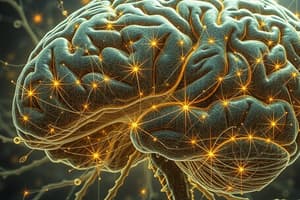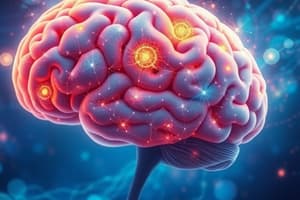Podcast
Questions and Answers
Which of the following is an example of a compulsion in OCD?
Which of the following is an example of a compulsion in OCD?
- Being anxious about self-stigma
- Repetitive hand washing (correct)
- Feeling responsible for others' well-being
- Having intrusive thoughts
What is the downward arrow technique used for in OCD treatment?
What is the downward arrow technique used for in OCD treatment?
- Identifying underlying beliefs related to obsessions (correct)
- Promoting self-stigma acceptance
- Encouraging avoidance of triggers
- Reinforcing obsessive thoughts
Which of the following is a common theme of obsessions in OCD?
Which of the following is a common theme of obsessions in OCD?
- Anxiety about being called mad
- Fear of causing a fire
- Responsibility for others' actions
- Need for symmetry and order (correct)
What does 'act-thought fusion' refer to in OCD?
What does 'act-thought fusion' refer to in OCD?
What type of behaviors or mental acts are considered compulsions in OCD?
What type of behaviors or mental acts are considered compulsions in OCD?
What is one of the aims of the lecture on TMS in OCD?
What is one of the aims of the lecture on TMS in OCD?
Which type of OCD symptom profile involves a focus on symmetry and ordering?
Which type of OCD symptom profile involves a focus on symmetry and ordering?
What is the lifetime prevalence of OCD in boys/men and girls/women?
What is the lifetime prevalence of OCD in boys/men and girls/women?
What does rTMS stand for in the context of OCD treatment?
What does rTMS stand for in the context of OCD treatment?
What is one aspect the lecture aims to cover regarding brain imaging methods and the study of OCD?
What is one aspect the lecture aims to cover regarding brain imaging methods and the study of OCD?
Study Notes
Compulsions in OCD
- Example: Repeatedly checking locks, appliances, or doors
- Definition: Compulsions are repetitive behaviors or mental acts an individual feels driven to perform in response to an obsession.
Downward Arrow Technique
- This therapeutic technique aims to help patients challenge the validity of their intrusive thoughts.
Obsession Themes
- Common Themes: Contamination, orderliness, aggression, and sexual content are frequently recurring themes.
Act-Thought Fusion
- Definition: An individual with OCD may believe that having a thought is equivalent to acting on that thought.
Compulsive Behaviors
- Mental Acts: Praying, counting, repeating phrases, or mental rituals
- Physical Acts: Washing, cleaning, checking, arranging, hoarding, or avoiding specific situations
Aims of TMS Lecture
- TMS in OCD: The lecture aims to help understand the use of Transcranial Magnetic Stimulation (TMS) in the treatment of OCD.
OCD Symptom Profile
- Symmetry & Ordering: Some individuals with OCD exhibit a strong focus on symmetry, order, and precision, leading to specific routines and rituals.
Prevalence Stats
- Lifetime Prevalence: The lifetime prevalence of OCD is estimated to be around 1.2%, with a higher rate among boys and men, and 1.6% among girls and women.
rTMS in OCD Treatment
- Definition: rTMS stands for repetitive Transcranial Magnetic Stimulation. It is a non-invasive treatment method.
Brain Imaging & OCD
- Objective: The lecture explores the use of brain imaging techniques like fMRI, EEG, and PET to study the underlying neurological mechanisms of OCD.
Studying That Suits You
Use AI to generate personalized quizzes and flashcards to suit your learning preferences.
Description
Test your knowledge on the clinical aspects of obsessive compulsive disorder, including symptomatology, epidemiology, and treatment options. Explore the pathological aspects and learn whether you should be concerned about OCD.




